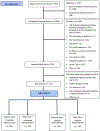Rationale, design, and baseline characteristics of WalkIT Arizona: A factorial randomized trial testing adaptive goals and financial reinforcement to increase walking across higher and lower walkable neighborhoods
- PMID: 31063868
- PMCID: PMC6544173
- DOI: 10.1016/j.cct.2019.05.001
Rationale, design, and baseline characteristics of WalkIT Arizona: A factorial randomized trial testing adaptive goals and financial reinforcement to increase walking across higher and lower walkable neighborhoods
Abstract
Little change over the decades has been seen in adults meeting moderate-to-vigorous physical activity (MVPA) guidelines. Numerous individual-level interventions to increase MVPA have been designed, mostly static interventions without consideration for neighborhood context. Recent technologies make adaptive interventions for MVPA feasible. Unlike static interventions, adaptive intervention components (e.g., goal setting) adjust frequently to an individual's performance. Such technologies also allow for more precise delivery of "smaller, sooner incentives" that may result in greater MVPA than "larger, later incentives". Combined, these factors could enhance MVPA adoption. Additionally, a central tenet of ecological models is that MVPA is sensitive to neighborhood environment design; lower-walkable neighborhoods constrain MVPA adoption and maintenance, limiting the effects of individual-level interventions. Higher-walkable neighborhoods are hypothesized to enhance MVPA interventions. Few prospective studies have addressed this premise. This report describes the rationale, design, intervention components, and baseline sample of a study testing individual-level adaptive goal-setting and incentive interventions for MVPA adoption and maintenance over 2 years among adults from neighborhoods known to vary in neighborhood walkability. We scaled these evidenced-based interventions and tested them against static-goal-setting and delayed-incentive comparisons in a 2 × 2 factorial randomized trial to increase MVPA among 512 healthy insufficiently-active adults. Participants (64.3% female, M age = 45.5 ± 9.1 years, M BMI = 33.9 ± 7.3 kg/m2, 18.8% Hispanic, 84.0% White) were recruited from May 2016 to May 2018 from block groups ranked on GIS-measured neighborhood walkability and socioeconomic status (SES) and classified into four neighborhood types: "high walkable/high SES," "high walkable/low SES," "low walkable/high SES," and "low walkable/low SES." Results from this ongoing study will provide evidence for some of the central research questions of ecological models.
Keywords: Adaptive interventions; Built environment; Financial incentives; Physical activity; Rewards.
Copyright © 2019 Elsevier Inc. All rights reserved.
Figures





References
-
- Troiano RP, Berrigan D, Dodd KW, Masse LC, Tilert T, McDowell M, Physical activity in the United States measured by accelerometer, Med Sci Sports Exerc 40(1) (2008) 181–8. - PubMed
-
- Brownson RC, Boehmer TK, Luke DA, Declining rates of physical activity in the United States: what are the contributors?, Annual review of public health 26(1) (2005) 421–43. - PubMed
-
- C. Centers for Disease, Prevention, Trends in leisure-time physical inactivity by age, sex, and race/ethnicity--United States, 1994-2004, MMWR Morb.Mortal.Wkly.Rep 54(39) (2005) 991–994. - PubMed

